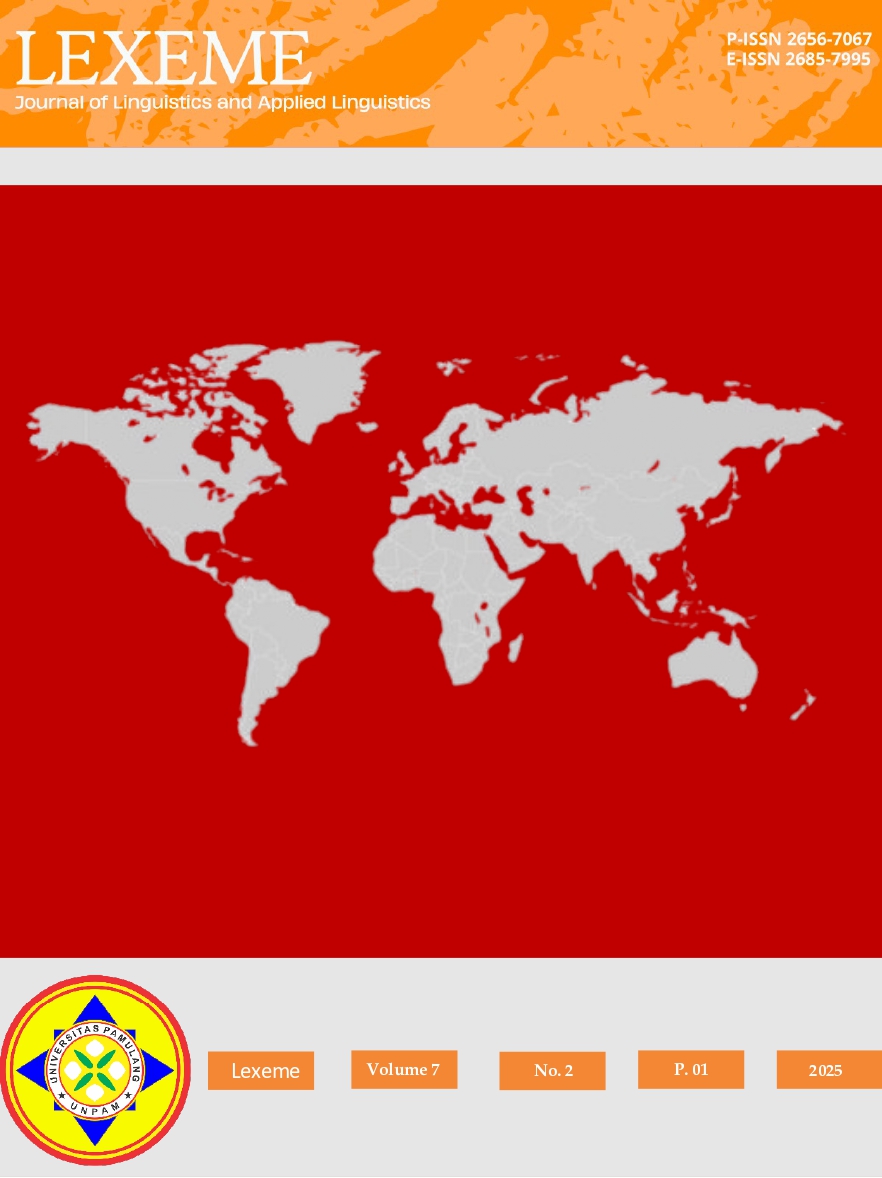Exploring Students’ Barriers to Code-Switching in English Classroom
DOI:
https://doi.org/10.32493/ljlal.v7i1.46977Keywords:
code-switching, English classroom, students’ barriersAbstract
Nowadays, studies on code-switching involving students have received limited focus, despite many research conducted on the university students’ code-switching. This study examines the contemporary issue of students’ barriers due to excessive dependence on code-switching in the English classroom. This phenomenological study employed a qualitative analysis technique and involved ten students from the English and Arabic departments of a state Islamic institution in East Lampung, Indonesia. The research data were acquired through observations and interviews with the participants. Additionally, the findings of this study indicate that a lot of students consider the social context, including the identity of the interlocutor and the situations code-switching occurs in the English classroom. Furthermore, most of students associated code-switching with the custom prevalent in their environment. This study also revealed that students consciously realize and admit barriers in the learning process. The barriers stem from the students’ excessive dependence on code-switching, hindering their ability to engage in tasks necessitating the usage of the target language. This study’s findings will offer significant insights for students to help reduce the continuing usage of code-switching by anticipating its future implications, which will assist lecturers in adjusting their approach to code-switching in the English learning process in each department.
References
Anggraini, D., Alhusna, A., Sari, V. N., & Andriani, D. (2023). The Effectiveness of Using Code Switching in Teaching English on Higher Education. Journal of Etika Demokrasi, 8(1), 13–25. https://doi.org/10.26618/jed.v
Astuti, C. W. (2020). Language Awareness: Language Use and Reasons for Code-Switching. LLT Journal: A Journal on Language and Language Teaching, 23(1), 116–130. https://doi.org/10.24071/llt.v23i1.2477
Baa, S. (2018). Lecturer Perceptions toward the Teaching of Mathematics using English as a Medium of Instruction at the International Class Program (ICP) of Mathematics Department of the State University of Makassar. Journal of Physics: Conference Series, 1028(1). https://doi.org/10.1088/1742-6596/1028/1/012131
Betti, M. J. (2021). The English Used in the Department of Arabic. April. https://www.researchgate.net/profile/Mohammed-Jasim-Betti-3/publication/351229469_The_English_Used_in_the_Department_of_Arabic/links/608c093c299bf1ad8d6b5b64/The-English-Used-in-the-Department-of-Arabic.pdf
Bhatti, A., Shamsudin, S., & Said, S. B. M. (2018). Code-Switching: A Useful Foreign Language Teaching Tool in EFL Classrooms. English Language Teaching, 11(6), 93. https://doi.org/10.5539/elt.v11n6p93
Entisar Khalifa Aljoundi. (2016). The strengths and weaknesses of code switching and bilingualism in the language classroom. 2013, May 2013. https://doi.org/10.13140/RG.2.1.5051.1762
Flyman-Mattsson, A., & Burenhult, N. (2009). Code-switching in second language teaching of {French}. Working Papers in Linguistics, 47(0), 59–72. http://journals.lub.lu.se/index.php/LWPL/article/view/2322
Istifci, I. (2019). Code-switching in tertiary-level EFL classrooms: Perceptions of teachers. Journal of Language and Linguistic Studies, 15(4), 1287–1299. https://doi.org/10.17263/jlls.668428
Jabeen, M. (2023a). Code-Mixing and Code-Switching Problems among English Language Learners: A Case Study of the University of Sahiwal. 6(3), 2023.
Jabeen, M. (2023b). Code-Mixing and Code-Switching Problems among English Language Learners: A Case Study of the University of Sahiwal. 6(3), 2023. https://www.researchgate.net/publication/376160698%0ACode-Mixing
Jogulu, L. N. (2024). Code-Switching As a Teaching and Learning Strategy in Esl Classrooms. International Journal of Humanities, Philosophy and Language, 7(26), 01–21. https://doi.org/10.35631/ijhpl.726001
Junaidi, A. M. (2019). The Communicative Function and the Benefit of Code Switching Within Bilingual Education Program or Multilingual Children in Learning English. Journal Ilmiah Rinjani_Universitas Gunung Rinjani, 7(2), 59–66.
Kiem, D., & Parcon, R. (2024). Challenges Encountered by College Students using Code Switching as a Medium of Instruction : Comprehension Skills in Focus. 7(2), 269–281.
Lestari, F. L. (2018). Conversational Code-Switching among Bilinguals in Junior High School Reunion Event. Humaniora, 9(3), 249. https://doi.org/10.21512/humaniora.v9i3.4868
Lipski, J. M. (2019). Languages in contact. In Biculturalism and Spanish in Contact. https://doi.org/10.4324/9781315100357-6
Macaro, E. (2017). Students’ strategies in response to teachers’ second language explanations of lexical items. Language Learning Journal, 45(3), 352–367. https://doi.org/10.1080/09571736.2014.905971
Miles, M. B., Huberman, A. M., & Saldana, J. (2015). Qualitative Data Analysis: A Methods Sourcebook (3rd ed.). SAGE Publications.
Muhtarom, M., & Maghfiroh, A. (2022). Student Difficulties in English Learning During Limited Ptm Period. International Journal of Research on English Teaching and Applied Linguistics, 2(2), 10–14. https://doi.org/10.30863/ijretal.v2i2.2450
Nahrowi, A. N. M. M. (2022). Code Switching in English Teaching Learning Process At Year in. 13, 144–155.
Prabowo KA, A., & Ambarini, R. (2022). Code Switching and Its Implications for Teaching in the English Language in Math Lessons by Early Childhood Education Teachers. KnE Social Sciences, 2022(1), 47–61. https://doi.org/10.18502/kss.v7i19.12428
Purma, R., & Moetia, M. (2023). An Analysis of Code Switching in Teaching Learning Process at SMPN 2 Manggeng. Jurnal Multidisiplin Dehasen (MUDE), 2(3), 389–394. https://doi.org/10.37676/mude.v2i3.4364
Putu, N., Cahyani, N. A., Made, I., Indrawan Jendra, I., & Sulatra, K. (2021). The Indonesian-English Code-Switching Used by Najwa Shihab and Agnes Mo on Catatan Najwa YouTube Channel. Social Science, Public Administration and Management (HUSOCPUMENT), 1(3), 101–106. https://www.publication.idsolutions.co.id/journals/index.php/husocpument/DOI:https://doi.org/10.51715/husocpument.v1i3.23
Savase, B. S. (2024). A Study of Advantages and Disadvantages of Code-Mixing and Code-Switching. Quarterly Reseach Journal, 49(2), 41–44. https://doi.org/10.13140/RG.2.2.11864.117.
Shafi, S., Kazmi, S. H., & Asif, R. (2020). Shafi, Kazmi, Asif .pdf. 7(1), 227–234.
Siswanto, P., Nugroho, A. S., Usmaedi, U., & ... (2022). Environmental Factors in the Production of Code-Switching in Pre-school Children: A Case study of Three Indonesian Children. Jurnal Pendidikan …, 10(1), 17–25. http://journal.um.ac.id/index.php/jph/article/view/15131
Talal, M. (2022). Students Perceptions towards Code-Switching in EFL Classroom. Pakistan Languages and Humanities Review, 6(II), 461–470. https://doi.org/10.47205/plhr.2022(6-ii)40
Vrika, R., Rezi, M., & Kunci, K. (2021). Diwan : Jurnal Bahasa dan Sastra Arab Lecturer ’ s Code-Switching in the EFL Classroom of Arabic Language and Literature. 13(1), 35–40.
Downloads
Published
How to Cite
Issue
Section
License
Copyright (c) 2025 Retno Prastiwi, Linda Septiyana, Yeni Suprihatin, Leny Setiyana

This work is licensed under a Creative Commons Attribution-ShareAlike 4.0 International License.







